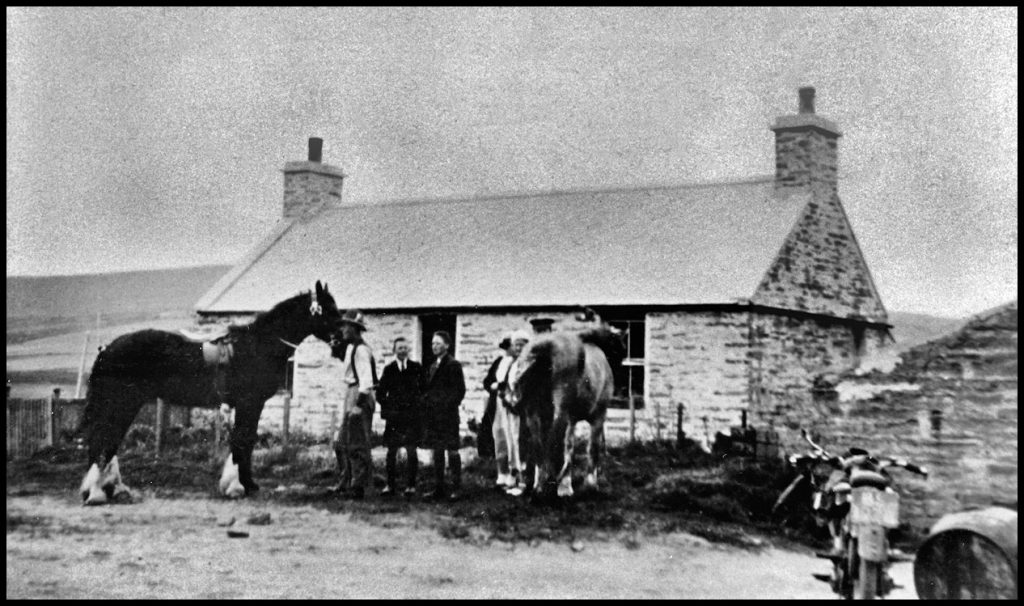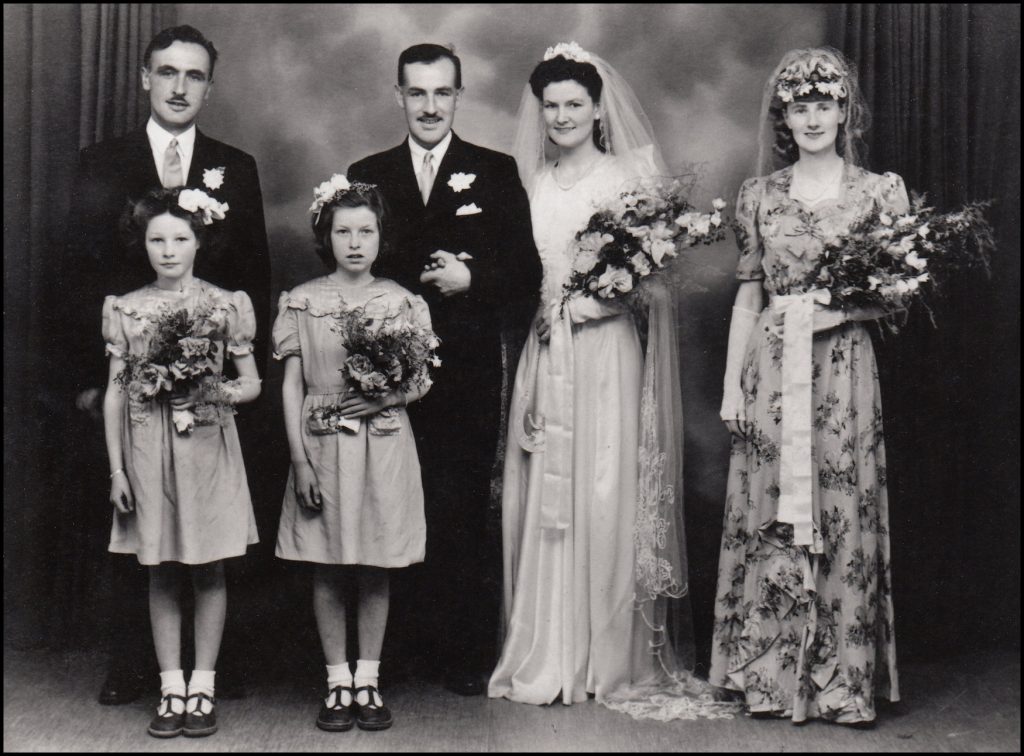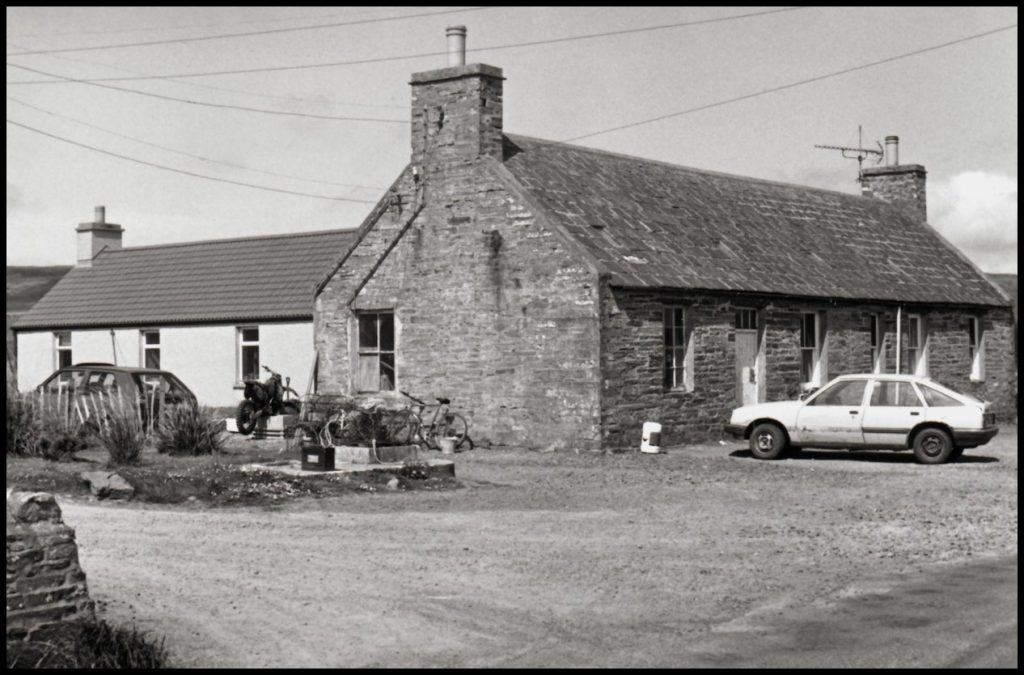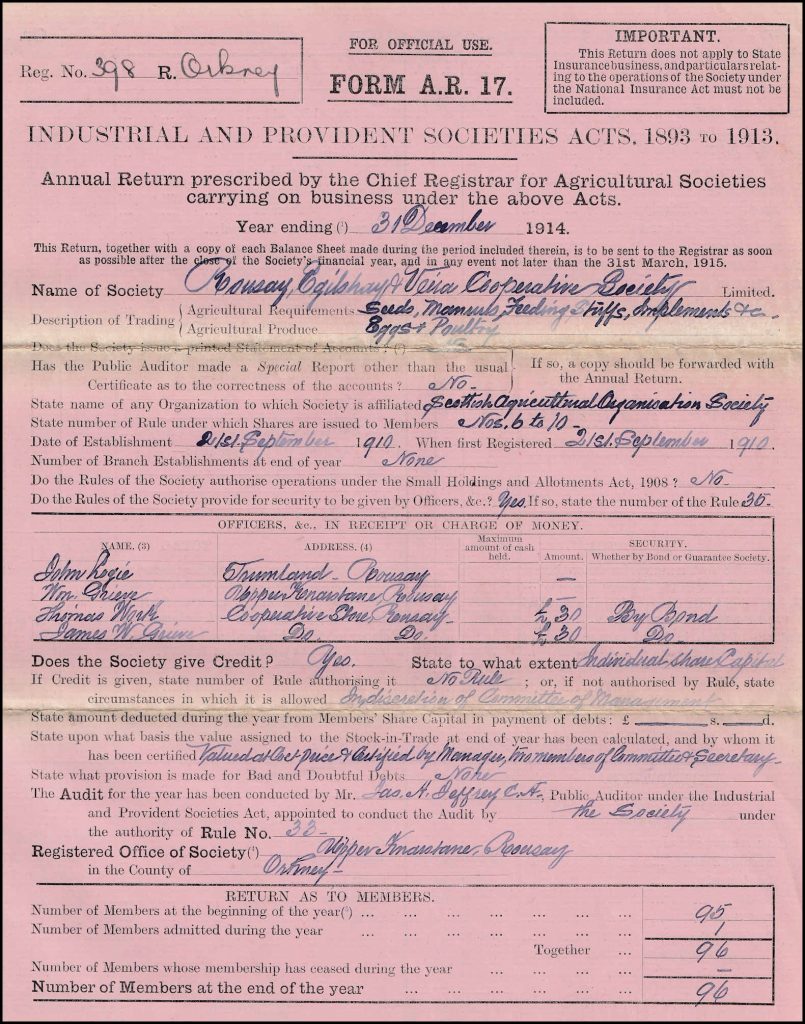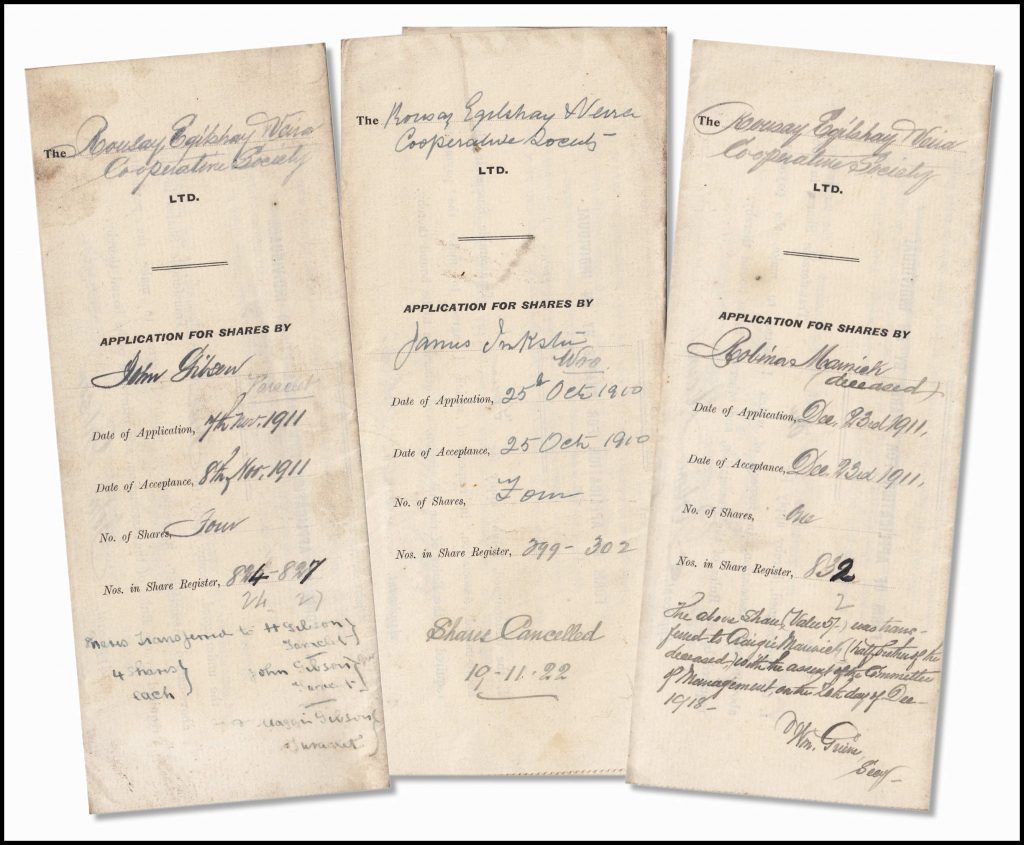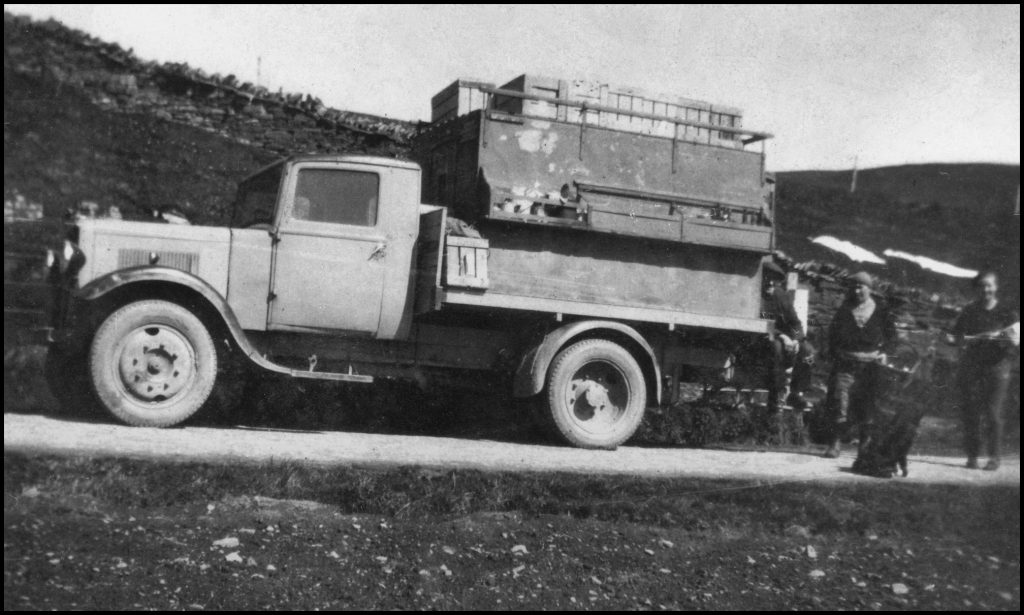The information below was forwarded by Bob and Bryan Inkster.
The Cop is local for The Northern Co-operative Society, or Co-op. It was a movement which built stores throughout Scotland by self help. It started in News [Newhouse], above Hullion, run by merchant/grocer John Sinclair [1824-1897]. The shop later moved to Clumpy in the hill behind the school in Sourin and eventually the shop, stable, sheepy hoose, and slaughter house were built on the bend of the road between the school and Old School. Hughie o’ Saviskaill told Bob that the men of Rousay all got together and quarried the stone to build the Co-op and Robbie Seatter of Banks gifted the land for it.
Craigern, pictured above, was built for the Craigie sisters who acquired the Cop because there was originally no house with it. The sisters were Annie and Bella Craigie, daughters of John Craigie, Shalter, later Triblo, and Betsy Leonard, Triblo. They bought the shop from the locally run Co-op and ran it successfully before they retired to Kirkwall. Documents regarding the transfer of ownership to the Inksters referred to the ladies as “the sisters Craigie”.
Jock and Dorothy Inkster moved to the Cop in the mid-1950s, Jock eventually taking over driving the post van from Roy Russell. When the family moved in the house was not joined on to the Cop and had an outside toilet and no running water for a family of four boys [the “boys o’ the cop”] and a grannie. Much later, Jock built the connecting part which thankfully included a bathroom!
John Inkster and Dorothy Mainland are pictured on the day of their wedding – Friday July 16th, 1948. Best man Robert Learmonth, and bridesmaid/maid of honour, Cathleen Craigie, Furse, with flower girls Mary Craigie, Hurtiso, and Linda Grieve, Saviskaill. John’s mother was Violet Inkster, daughter of David Inkster and Isabella Sinclair, Cavit. He was born in 1922, before Violet’s marriage to Robert Learmonth. That marriage produced two offspring: Anna and Robert. Dorothy was the daughter of Hugh Mainland, Gairsay, later Hurtiso, and Alice Craigie, Falquoy. John and Dorothy had four sons: John, Robert, Bryan, and Steven.
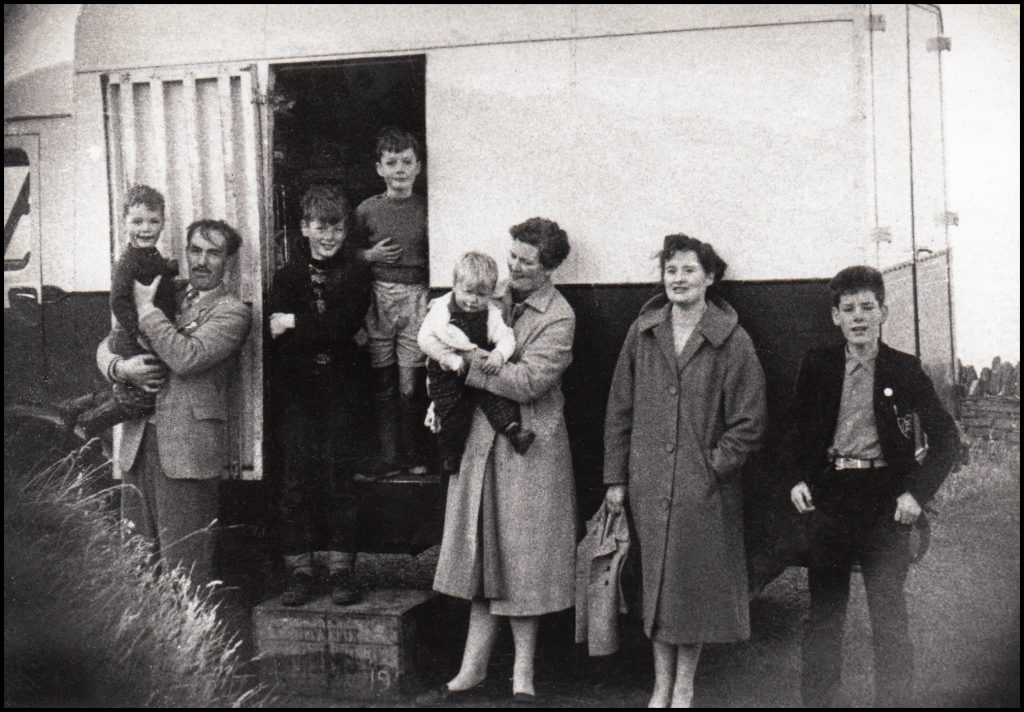
To the left is Stevie and John Snr; Bob and Bryan in the doorway; Dorothy holding young Stanley Aim; Mrs Aim [from Holm]; and John Jr.
Photo taken by Ronnie Aim.
The Cop hoose had gas lighting when we first went there which was considered sophisticated compared to the Tilley. The shop had a J.A.P. lighting plant which sat in the “Sheepie Hoose”, the small concrete shed to the North of the shop, used for starving sheep prior to slaughter. The slaughterhouse is the lean-to on the North end of the Cop. It had a sloping floor with a drain to a large cess pit. The North end of the main building was called the “Mealy End”, where sacks of meal, flour, Cosetas etc were stored. Cosetas was an animal feed which came in large sacks and consisted of flakes of yellow vegetable matter. Bryan thinks it might have been made from maize, for he remembers eating it and found it was quite palatable!
The Inksters got the Old School too, after Sandy Logie moved to the toon. Jock’s stepfather, Bertie Learmonth lived there for a spell but mostly it stood empty until Jock fixed it up for his retirement.
Sandy’s brother, John Gibson Logie, was a private in the Gordon Highlanders regiment. He was 37 years of age when he died of wounds received during the capture of Beaumont-Hamel, a tactical incident that took place during the Battle of the Somme on November 22nd 1916.
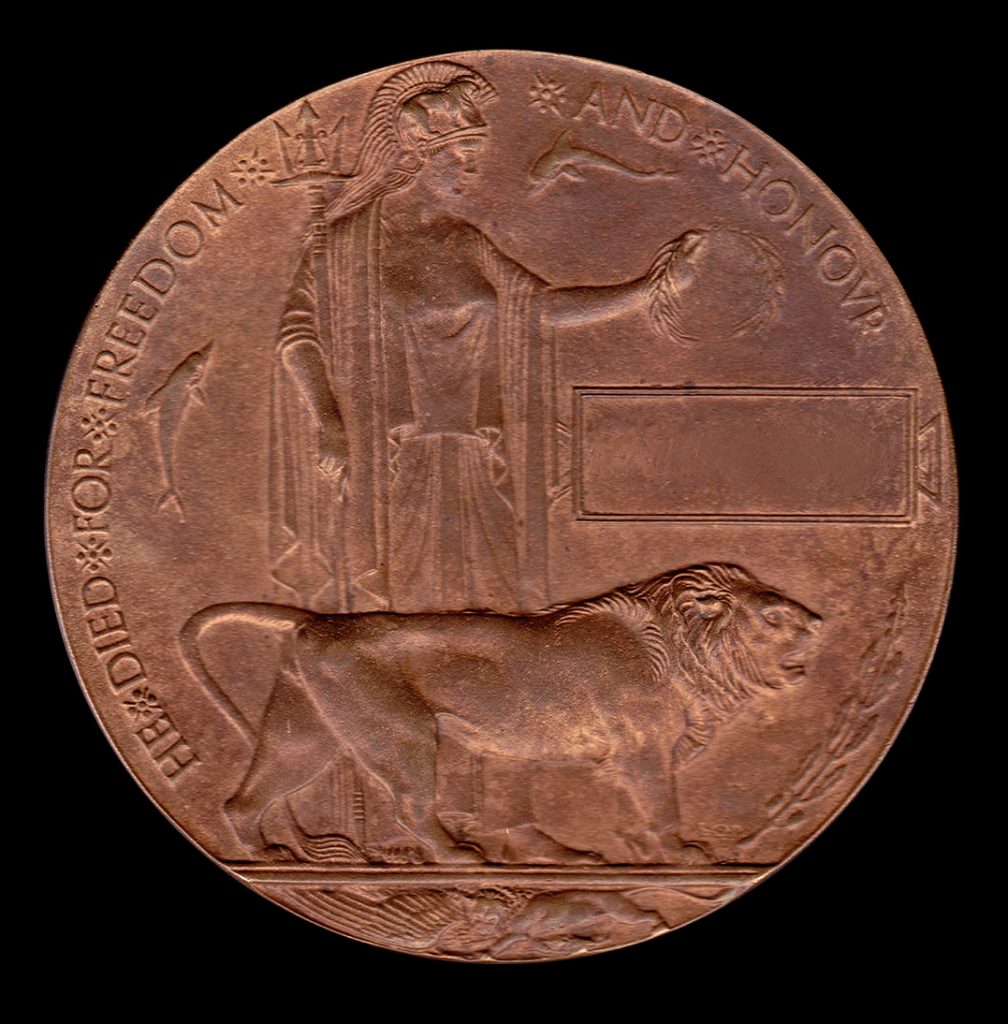
A bronze Memorial Plaque, or more commonly known as the ‘Dead Man’s Penny’, was issued after the First World War to the next-of-kin of all British and Empire service personnel who were killed as a consequence of the war. The plaques were about 4.75 inches in diameter, were cast in bronze, and came to be known as the ‘Dead Man’s Penny’, because of the similarity in appearance to the much smaller penny coin of the day which itself had a diameter of only 1.215 inches. Sandy had the large ‘penny’ displayed on the mantelpiece above the fireplace in the Old School for many years.
Bob and Bryan, when in their very early teens or perhaps younger, were helping to rip out an old fire place in the Old School when they found the ‘death penny.’ The boys used the building as a motorbike workshop and spent a lot of their time trimming up the old pre-war bikes which abounded in Rousay at the time. Sandy Logie had previously told them to watch out for the Death Penny if they ever renovated the building. They excitedly took their treasure to show to their parents. Jock got in touch with Sandy Logie and he could remember it falling down behind the fire place and being unable to get it out and over time he had forgotten about it. Much to the boy’s disappointment their ‘treasure’ was reunited with Sandy but he was happy to have it back!
As a boy Bob used to go on the delivery run with his father and the highlight was the stop at Trumland Farm with Robert Johnston because they got in to watch TV (first in the island) – The Lone Ranger and Whirly Birds being favourite programmes.
Bob’s wife Sally was working in the Post Office in the early ‘70s and there was some fuel crisis and petrol was going to be rationed to only those with valid road tax. They had a sudden influx in road tax applications. Sally was paid £12 a week for running the post office then.
The boys got sixpence worth of sweeties every Monday and they would go to Dot Munro at the shop for it, but they would always go again later in the day claiming they hadn’t gone before. Needless to say Dot never fell for it. Bob and Bruce Mainland decided they could maybe distract Dot and pinch some sweeties. Bruce got the distracting job and Bob grabbed the first packet he could reach. They opened up the package only to find what they thought were something like surgical masks, which they hooked round their lugs and ran around with only to discover later they were in fact sanitary towels!
The Rousay, Egilshay, & Veira Co-operative Society was established on September 21st 1910, and when this annual return for the year ending 31 December 1914 was completed the society had 96 members belonging to the Rousay community.
Society Officers who were in receipt of or in charge of money were as follows: The treasurer was John Logie, land steward of the Trumland estate and caretaker of Trumland House; the Secretary was William Grieve, residing at the Society’s registered office at Upper Knarston; and Thomas Work and James W. Grieve, c/o the Co-operative Store in Sourin. Detailed accounts were kept regarding cash receipts and payments, trading expenditure and income, and profit and loss. When all the figures were tallied up the society’s assets stood at £810 19s. 9½d.
Another annual return for the year ending August 31st 1928 recorded the society’s description of trading. Agricultural requirements included grocery, drapery, boots, stationery, paints, oils, tar, nails, feeding stuff, seeds and manures. Agricultural produce included eggs, butter and cheese. Harry Gibson, Braes, was manager at this time, and John Harcus, Clumpy, was employed as van-man. Payments and expenditure included the upkeep of the horse that pulled the van, and a donation of £5 to the Balfour Hospital. That year’s closing figure was £2,379 9s. 0d.
Below I have selected just three from a large collection of Rousay, Egilshay, & Veira Co-operative Society share certificates in the possession of Bob Inkster.
On the left is that of farmer John Gibson, Faraclett. He had four five-shilling shares, which were later transferred to sons Hugh and John, and daughter Maggie.
In the centre is the certificate belonging to farmer James Inkster, Woo. Purchased in October 1910, his four shares were cancelled in November 1922.
Robina Marwick’s certificate to the right shows she bought just one share in December 1911. She was born in January 1832, the daughter of James Marwick, Eastaquoy, and his first wife Jean Marwick. After her death Robina’s single five-shilling share was transferred to her half-brother Craigie Marwick on the 20th day of December 1918.
Adele Marie Park has memories of the Cop – she stayed with Tommy and Adeline Inkster at nearby Woo.
“I mind the shop weel. Granny o the Co-op – I have her recipe for Clootie Dumpling, still mak it. I remember Dorothy and the boys of course, Stevie, and John. They had petrol pumps, Esso, and I fell in love with the plastic tiger head on top of the pumps. When they changed the head or something, Dorothy gave me the plastic tiger head; there is a photo of me in the garden at Woo with it, looking pleased as punch. I remember one poppy day we had gone up on Saturday and I had bought a green toy soldier with a parachute, the kind you throw up in the air and they float down with the parachute. I played with him on the Sunday then when the poppies came down on the television. I threw him in the air to come floating down. It was a big thing to a kid. I thought I was taking part in the ceremonies and remembering the soldiers who died. Dorothy was always smiling and Granny lived in the cottage across from the shop. Sweeties, smiles, and magical things – it was a fantastic shop and the people were magical.”
Phyllis Muir, daughter of Archer and Doll Clouston, Upper Knarston, later Glebe, writes:-
“The Co-op, or ‘Cop’ as we would pronounce it, was the shop that my folks mainly used as it was the nearest and as most journeys were made by bike, the road there and back was fairly flat, apart from the brae of Quoys. There were no freezers until the Hydro came to the island so a trip to the Cop for fresh food was necessary on certain days of the week. Thursday in particular sticks in my mind as it was Orcadian day and the paper had to be got that day. Fresh meat and bread also came that day so by the time the supplies got there, about lunchtime, there would often be a queue but the aim always was to get there before the Egilsay men. I don’t think there was a shop in Egilsay so a small boat, with 2 or 3 men, used to cross Egilsay soond and land below Banks. They would do shopping for a number of households, load it into sacks which got slung over their shoulders and off they would set back across the fields. I remember it being a total pain if you had to wait until they had been served! Although, if the weather was bad nobody minded if they jumped the queue so that they could get home before it got dark. It was also recommended not to be in a hurry shopping when the mail came in as it had to be sorted. Dorothy Munro helped in the shop and she also delivered the mail to the Sourin houses.
“The shop was always well stocked with the basics and at one end there was the post office. My mother relied on ‘the Family Allowance’ for cash so her book would be cashed at one end then spent at the other! Although at that time it was common for people to have a ‘book’, where everything was written in as it was bought and then paid for at the end of an agreed period, maybe a month, 3 months or longer. My father would pay by cheque having checked what had been bought. He would sometimes moan about ‘unnecessary’ purchases, in his mind, but he smoked at the time so he never got far with that argument!
“The Cop was in a way a social meeting place. If my sister Marlene and I had cycled there we were always asked who had been at the shop and whether there was any news on our return. Marlene was always better at getting the gossip than me!”
Tommy Gibson tells of Sourin shops and shopping in the past:
The shops in the district were at Guidal, Isaac Marwick was a general merchant also a joiner shop and cobbler. Many other things took part as well. The registrar was at Guidal for many years. The odd tooth was extracted, hair was sometimes cut. Another shop was at Banks; this was situated in the east end of the dwelling house. This shop closed in 1896 when the Mainland family left Banks and the Seatter family came from Ness in Westray. The Seatters lived and farmed in Banks till the mid 1960’s. In 1870, James Yorston started up a small grocery store at the Old Man. I would have thought that this was not a very good site, but he carried on and was taken over by a Co-op about 1890. A new building to house the Co-op was built near the school. The Co-op was moved to its new premises about 1906. A house was then built for the manager. The Co-op used to employ 3 to 5 workers. They were managers, van men and assistants. The van went out most days with deliveries and for collections. A horse van was used for delivery and collections. The Co-op kept a horse for the van, but when the van was due for Wasbister, the horse of Woo was traced into the van. This horse helped pull the van to the top of the Sourin Brae. A two-ton Commer lorry was then purchased in the mid 1930’s. The Co-op stable was converted as a garage to house the lorry. For deliveries and collections the platform was used; old lorries were high and the platform was about 5ft. 6ins above the ground. Top speed was about 30 mph. For selling groceries, the old horse van was converted to fit the lorry, with an arrangement at the rear for the elderly and infirm to get into the van. There was a remarkable amount of groceries in the shelves for sale. The van usually stayed on the public road, but if a farm road was good the van went to the house. When the van was not used, an endless chain fixed to the garage roof lifted the van off the platform.
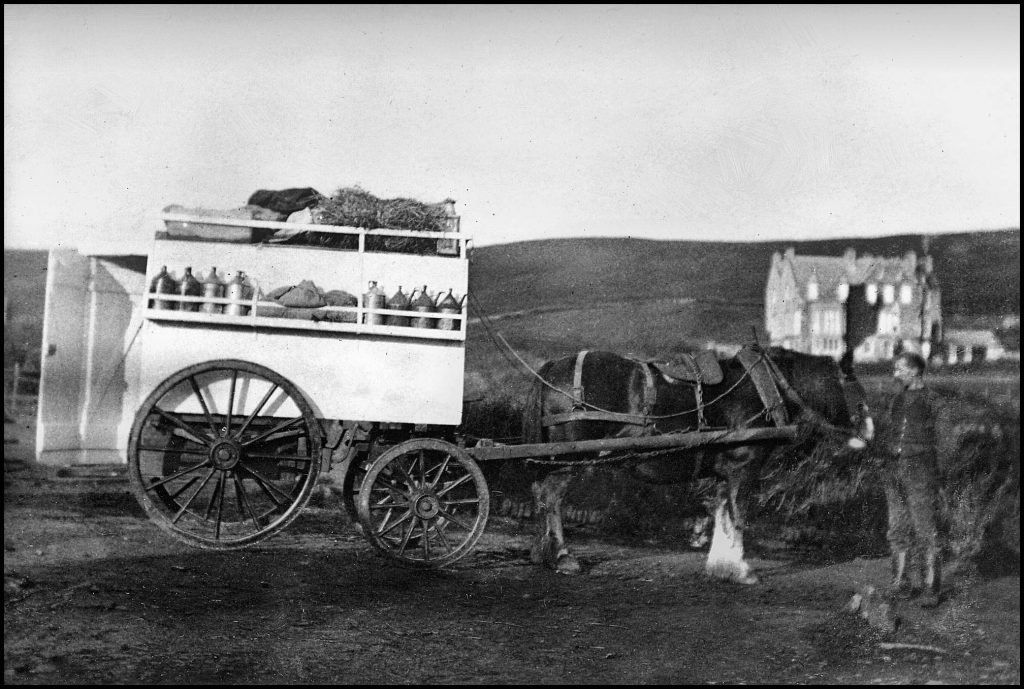
The van man was James William Grieve of Whiteha, and the horse was named Prince
and came from Faraclett. Paraffin drums can be seen on the side of the van.
Some van men I remember were John Seatter of Banks, then John Grieve, Digro, Fred Craigie of the Bu in Wyre. This shop, like the Hullion one, was remarkable. The shops carried all the groceries and animal and poultry feeds, oils, tools, and hardware needed by all the families in their respective districts.
The first manager was a Mr. Work from the Mainland; next was Sandy Grieve of Nethermill, then Harry Gibson, whose parentage came from Upper Knarston, married Hannah Grieve, Fa’doon. By the 2nd World War a Mr. Walls from Rendall took over as manager. Mr. Wall’s son Thomas lost his life in the war in Burma building an infamous railway. The next manager was Magnus Flaws from Wyre, then two brothers from Kirkwall John and Gib Taylor was manager and store man respectively.
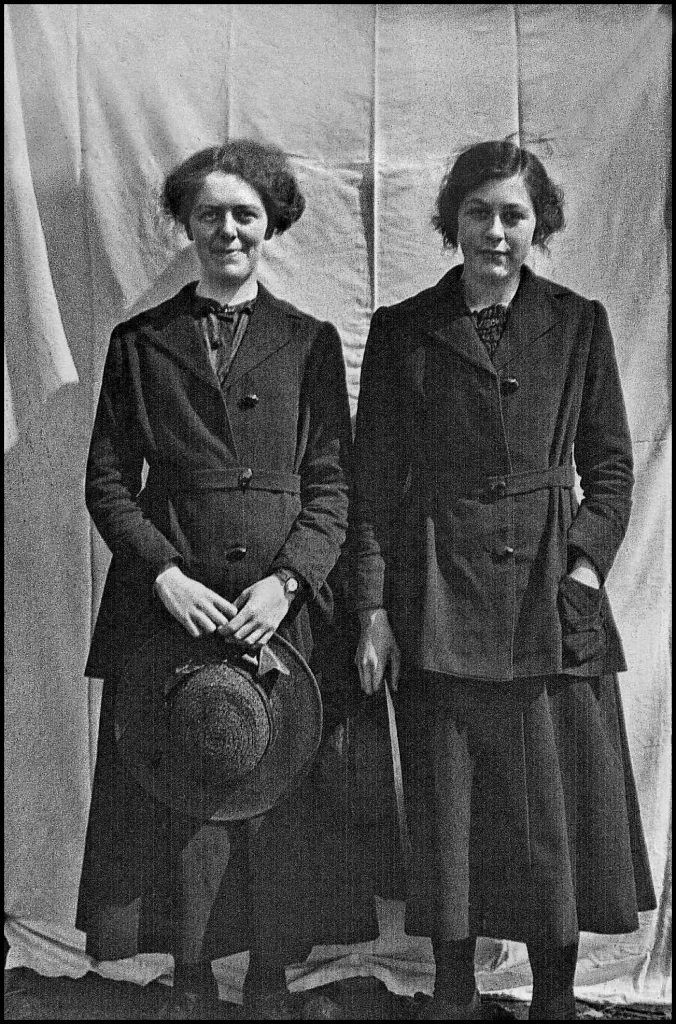
Two ladies were next, Annie and Bella Craigie [pictured left]. They were born at Treblo. Their father, John Craigie, owned the Queens Hotel in Kirkwall. He had been a miller in Sourin for many years. John and Dorothy Inkster, from Hurtiso were next. They had the post office and telephone exchange. This was transferred with them. The Sourin Shop as it was then, closed in 1973-4. It was sad day for Sourin. At one time the shop did deliveries of animal and poultry feed and collected 1000’s of eggs. Hullion’s shop closed in 1989. This was transferred to Marion Clark who opened a shop at Essaquoy in November. Shelves were erected, groceries were bought, and a large van was acquired. A remarkable amount of groceries adorned the shelves. Petrol pumps, and a tarmac road for easy access were put in in 2000. The first recorded shop was at the Oldman in the 1871 census, with Robert Yorston. This would have been, to say the least, modest. With merchants at Banks, Guidal and the Co-op, and a period of about 15 years without a shop, Sourin folk have been shopping for 115 years.
Reproduced, with permission, from his book In Dreams We Moor, Robert Craigie Marwick tells us about his experience of ‘The Cop’.
Next door to the school is the former Co-op shop and store. All through my childhood the Co-op van was a familiar sight on the road as it did its twice a week circuit of the island. At first it was pulled by two horses but in the 1930s a lorry was acquired and the van body was carried on that. The van carried not only groceries and a selection of small household goods but also numerous two-gallon cans of paraffin stacked in racks on the outside. Everyone needed paraffin for oil lamps in those days when no one entertained thoughts of mains electricity ever reaching the island. At that time the old wick lamp with its flame protected by a glass funnel was beginning to give way to the much brighter Tilley lamp which burned vaporised oil within a delicate, gauze mantle. One minute the vanman might be measuring out a gallon of paraffin for a customer and the next handing her an unwrapped loaf of bread. Hygiene was not something that was of great concern to the vanman. He probably had never heard of the word but it is likely that neither had some of his customers. When I recall the lack of hygiene in the handling of food in those days it makes me wonder how any of us survived.
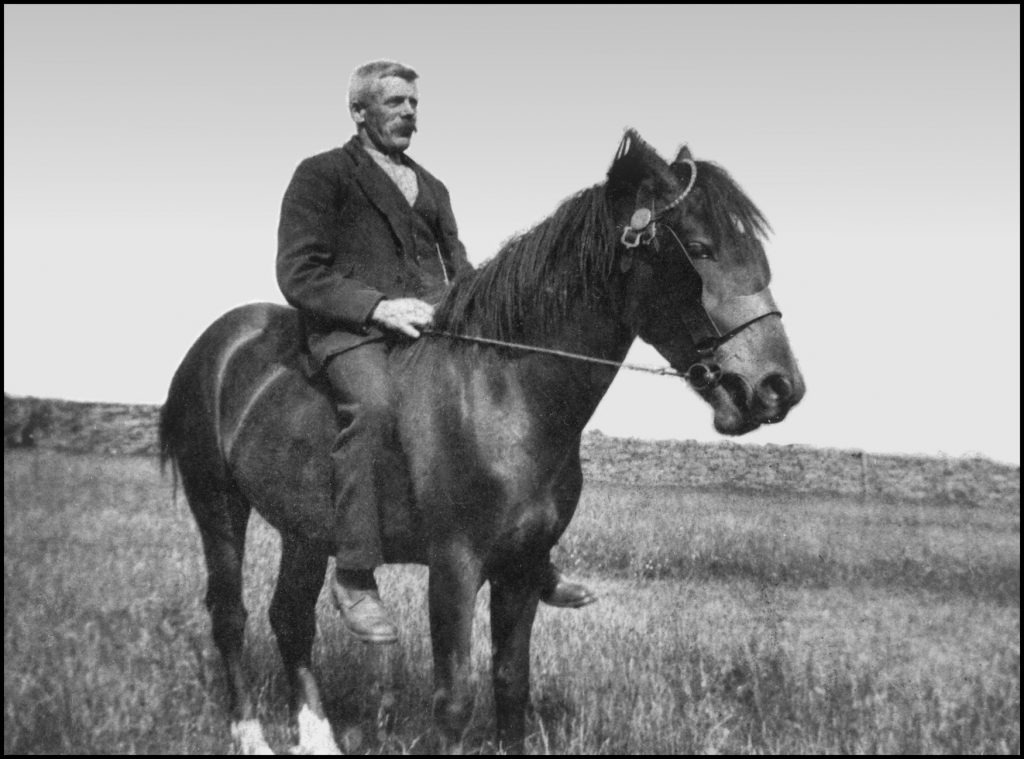
On its rounds the van collected large quantities of eggs which the farmers’ wives brought along to exchange for their groceries. Before the lorry appeared on the scene the conveyance of eggs had become an increasing problem because near the end of the Saturday round, late at night, the van had to ascend the very steep Leean road, a tough task for the horses at the end of a long day.
The first vanman I remember was Sammy Inkster who was a very small man. Although having the misfortune to be slightly hunchbacked he appeared to us children to be very strong as he heaved large bags of poultry feedstuff about with apparent ease. It amused us that every heave was accompanied by a very audible, and probably involuntary, “Humph!”
Sammy [pictured above] had a mile or two to travel to work [he lived at Kirkha’] so he acquired a motorbike. One day when it came time for him to go home for dinner he started the machine, let the clutch in and tried without success to move off. He revved the engine a bit more but still the machine would not move. This was because, unknown to Sammy, two of the bigger boys from the school had sneaked up behind him and had lifted the rear wheel just clear of the ground. Then, as Sammy revved the engine even harder, they let go and the machine, with Sammy holding on for dear life, shot off like a bullet from a gun. As with many of the practical jokes perpetrated in those days, it is unlikely that the possibly dire consequences of this one had been given much thought.
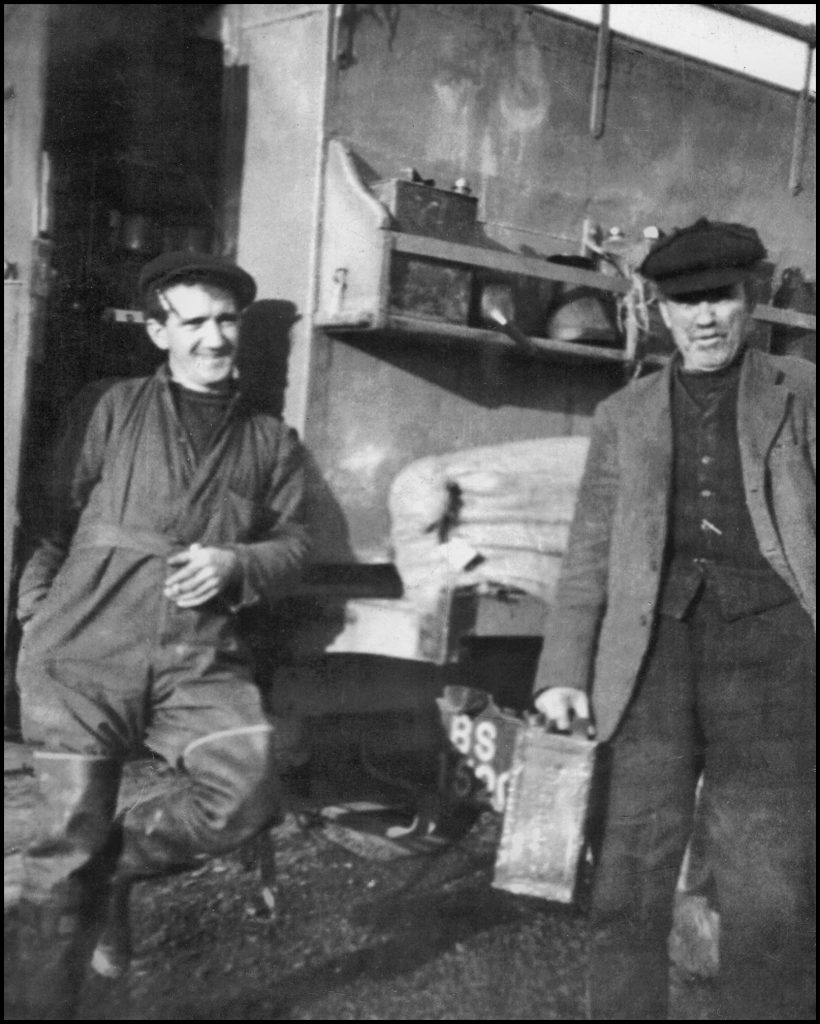
‘The Rousay Co-op Van’ – posted by Gordie Peterson on the Orkney Communities Image Library in November 2006, is reproduced here with his permission.
He writes: This photo, shows my grandfather Jacko Linklater (left) with the Rousay Co-op van, delivering to Jock (Craigie) o’ Breck in 1938. Just why a vanman needed thigh boots I have no idea!
Robert Craigie Marwick added the following comment:-
I remember an occasion when Jacko finished work late at the Co-op store next door to the hall where there was a dance in progress. He was keen on dancing so, without wasting time going home to change, he crossed the road to the hall, rolled down his thigh boots, and danced the night away, as nimble footed a performance as you could have wished for.
[All black & white photos, unless otherwise stated, are from the Tommy Gibson Collection]
